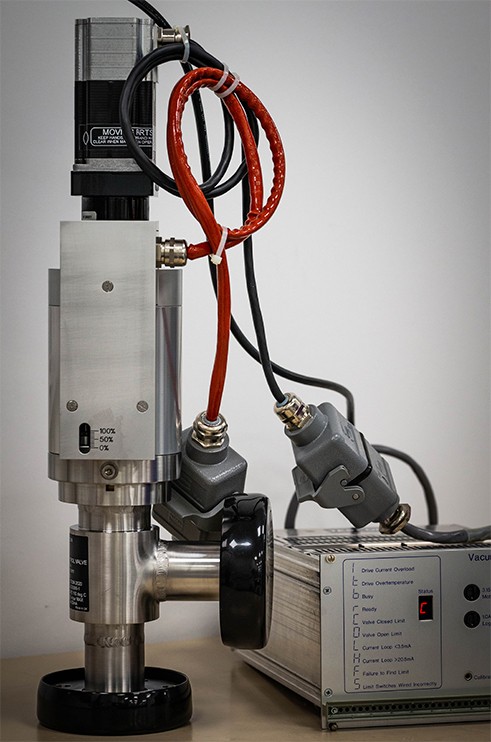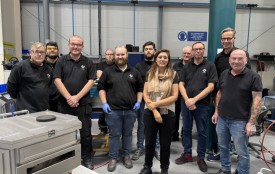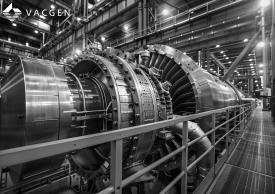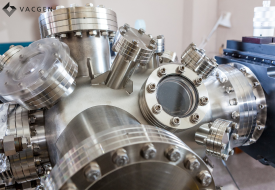Understanding the hardware behind vacuum systems is an important part of maximising a vacuum’s efficiency, reliability, and accuracy. At the heart of these systems, vacuum valves play a critical role in how robust a vacuum system is. Let’s explore the differences in valve types and actuation methods.
Gate Valves
Designed to control or isolate gas flow, gate valves work by raising or lowering a 'gate' inside the valve, effectively isolating different chambers within the system. When fully open, they offer virtually unrestricted gas flow, making them ideal for high vacuum (HV) and ultra-high vacuum (UHV) applications. The large ‘gate’ opening allows for substrates and instruments to be passed through subsequent chambers, without too much change in ambient chamber pressure.
In processes like thin film deposition and surface analysis, gate valves can be used to isolate 2 vacuum chambers allowing 1 chamber to remain at UHV and the other to be at atmosphere – this would typically be the case for a load lock chamber which allows the scientist to load a sample into the system and maintain the very best process pressures.
Angle Valves
Angle valves are primarily used to isolate regions in pumping systems. Their design mitigates the risk of contaminants reaching crucial components when the valve is open, thus preserving the overall health of the vacuum system. This function is particularly useful in processes like mass spectrometry and vacuum furnaces, where maintaining uncontaminated vacuum conditions is vital to the process.
The main difference with an angle valve to a gate valve is that there is no line of site view through the valve and so cannot be used for passing samples and substrates through.
Leak Valves
Leak valves regulate gas flow. Their role is to introduce controlled quantities of gas into a vacuum system, creating specific pressure conditions. They’re used in processes such as sputtering, where a controlled flow of inert gas such as Argon is flooded into the chamber. The charged ions accelerate towards the target material, bombarding the surface and creating a plasma plume, which is then deposited onto the substrate surface. The design eliminates hysteresis and is perfect for applications where precise control over gas flow and pressure levels is required.
In terms of actuation methods, leak valves can be manually operated, or motorised. Motorised valves use an electric motor to control the flow of gas by restricting the input. The choice between manual and motorised depends on the application’s precision requirement, safety, cost-effectiveness, and compatibility with the existing system.
Flanges
Flanges, the connecting interfaces on all vacuum components, allow the assembly and disassembly of system components like vacuum valves and pumps. They come in various sizes and types, such as fixed and rotatable. By ensuring secure connections and vacuum-tight seals, flanges contribute to the system's integrity. When selecting valves, you need to ensure the flanges you want to connect to are compatible.
The Choice of Seal
They say a chain is only as strong as its weakest link, so seals are just as important as the valves themselves. These vital components range from Viton seals to copper and silver-plated seals. The choice of seal is critical as it affects the overall vacuum performance and the bakeability, that is ability to withstand high temperatures. The choice of seal is based on the system's operating conditions, such as pressure and temperature ranges, and the specific application requirements.
Limit Switches
Limit switches are electromechanical devices used to monitor the position of valves and other movable components. They’re crucial for managing reliability in a vacuum system and ensuring functions like sample transfer can't happen unless the gate valve is fully open; or pumps can’t be vented unless the chamber gate valves are in the required position.
Each part of the valve system plays a unique role in analysis and deposition processes.
Gate valves provide smooth, unobstructed gas flow, crucial for maintaining high vacuum conditions and isolating various parts of the system whilst allowing you to transfer components through the large aperture.
Angle valves safeguard sensitive system parts, preserving the integrity of vacuum conditions needed for precise analysis, whilst providing excellent conductance and leak valves, with their controlled gas introduction, support various deposition and analysis applications.
In conclusion, vacuum valves comprise a number of elements working together to help ensure the smooth operation of vacuum systems. By understanding how they work we can use them to their maximum capability, easily and safely.








